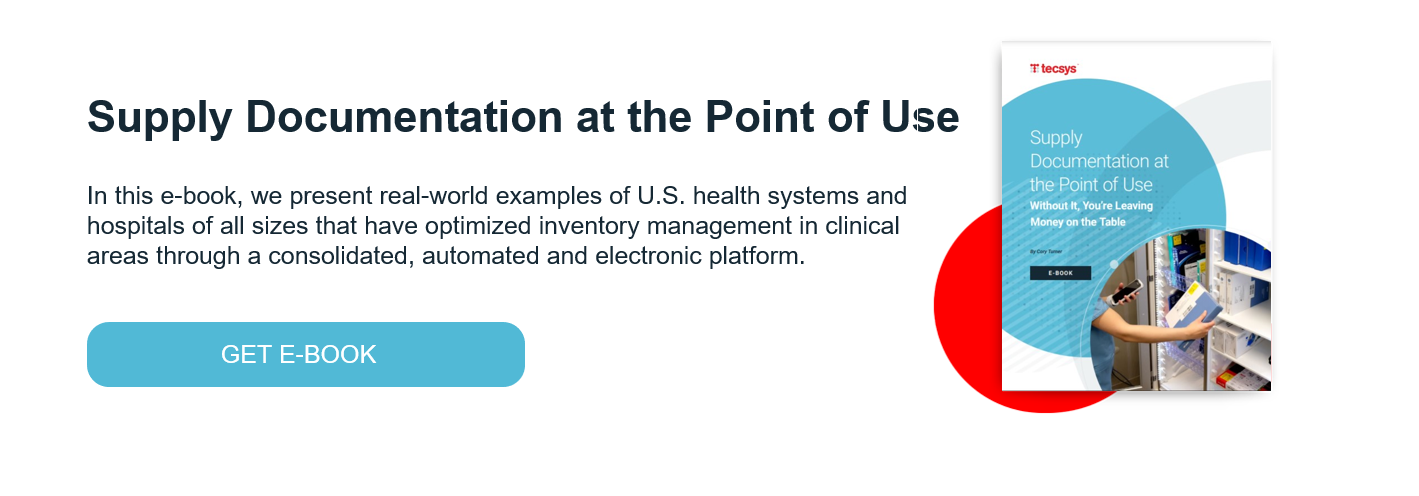Why the Sunsetting of Omnicell’s OptiFlex Presents a Strategic Opportunity to Modernize

We’ve been hearing from our customers how Omnicell’s OptiFlex point of use (POU) system is ceasing production and support for its medical/surgical supply cabinets.
You could replace Omnicell’s OptiFlex with another standalone, par level inventory tool to address one piece of your supply chain puzzle – replenishing high-volume, low-cost supplies in your nursing units. But that will just give you the same silo of information that you already have.
Instead, take this opportunity to assume control over all medical/surgical inventory – from the point of receipt through the POU to the patient’s bedside – with an end-to-end supply chain management (SCM) system that is integrated with your enterprise resource planning (ERP) and electronic health record (EHR) systems.
Here’s what you can expect by integrating an end-to-end supply chain platform:
- Gain visibility into all supplies in all areas, including high-cost, critical items used in the perioperative space, cath labs and IR labs.
- Leverage barcode and RFID technology to manage inventory, track product usage and automate EHR documentation.
- Enable clinicians to capture more billable items and generate greater revenue for your health system.
Consider it a starting point into supply chain optimization and a way to progress your organization’s modernization and maturity journey.
That’s the approach McLeod Health has taken. Last year, the health system implemented Tecsys’ SaaS-based Elite™ Healthcare supply chain execution platform across its hospitals to automate and optimize inventory and replenishment management in POU clinical areas, including ORs and cath labs.
“With Tecsys across our clinical areas, our organization will have access to more accurate usage data and analytics. This helps us be more efficient and better positioned to make strategic supply chain decisions that maintain our standards of excellence while optimizing inventory availability and controlling costs,” said Carmen Winfield, vice president of Procurement Service for McLeod Health.
Here are five reasons why the sunsetting of Omnicell’s OptiFlex can be a strategic opportunity for your health system’s supply chain, backed by real-world examples from U.S. health systems.
5 Reasons Why the Sunsetting of Omnicell’s OptiFlex Presents a Strategic Opportunity
1. Lower Costs and Reduced Waste
With end-to-end inventory tracking, you can take steps to optimize supply usage, lower costs by purchasing only what you need and reduce waste. This includes both medical/surgical supplies in your nursing units and items in specialty areas most important to manage from a patient safety and cost perspective (e.g., implants).
Case in point: A 450-bed regional healthcare system in the Northeastern U.S. achieved $1.35M in savings in 12 months, including $660K in expired product recovery, across its cath labs and IR labs.
2. Greater Revenue Capture
Accurate supply documentation in the EHR is critical to charge capture and subsequent payer reimbursement to your organization. An SCM solution with automated POU product data capture and seamless integration with the EHR and financial systems helps ensure all products used in a case were documented. Complete charge capture means greater revenue generation for your organization.
Case in point: Munson Healthcare, a nationally recognized regional nonprofit health system, achieved 25% greater charge capture on the same procedure volume in its cath labs.
3. Better Use of Clinical Resources
Supply chain tasks are a notorious drain on clinical resources. An SCM solution that automates inventory management in the ERP and supply data capture in the EHR helps redirect clinician time from supply management to patient care.
Case in point: At Concord Hospital, a regional medical center in New Hampshire, nurses spend 37% less time on supply chain activities, with 5,800+ hours returned to clinical care.
4. Improved Patient Care and Safety
By gaining real-time visibility into all supplies used in all patient care areas, you can better manage these assets, help ensure they are available when and where they are needed and avoid using expired or recalled products on patients.
Case in point: Mercy, one of the top five largest U.S. health systems, reduced serious reportable events by 71%.
5. Advanced Analytics
With an enterprise-wide SCM platform, you have a single source for accurate and complete data on everything supply-related across your entire organization, including all inventory storage and clinical areas. With real-time advanced analytics at your fingertips, you can make decisions that will drive improved operational and financial performance across your organization.
Case in point: A state-owned, not-for-profit integrated health care system with 11 hospitals in the Southeastern U.S. achieved $1,752,500 in total hard gains value within 16 months, including inventory optimization and carrying cost reduction.
Here’s Where to Start
While the end goal for each healthcare organization cited in this post is enterprise-wide inventory visibility and control, they started their journeys in different places.
Some addressed the immediate need of replacing their Omnicell OptiFlex medical/surgical supply cabinets in the nursing units, while others began by targeting a pain point, such as revenue leakage in the perioperative space.
The Tecsys Elite™ Healthcare platform offers the flexibility to begin inventory optimization where it makes the most sense for your organization – whether it’s establishing a consolidated service center (as in the case of McLeod Health) or targeting one POU supply area at a time.




